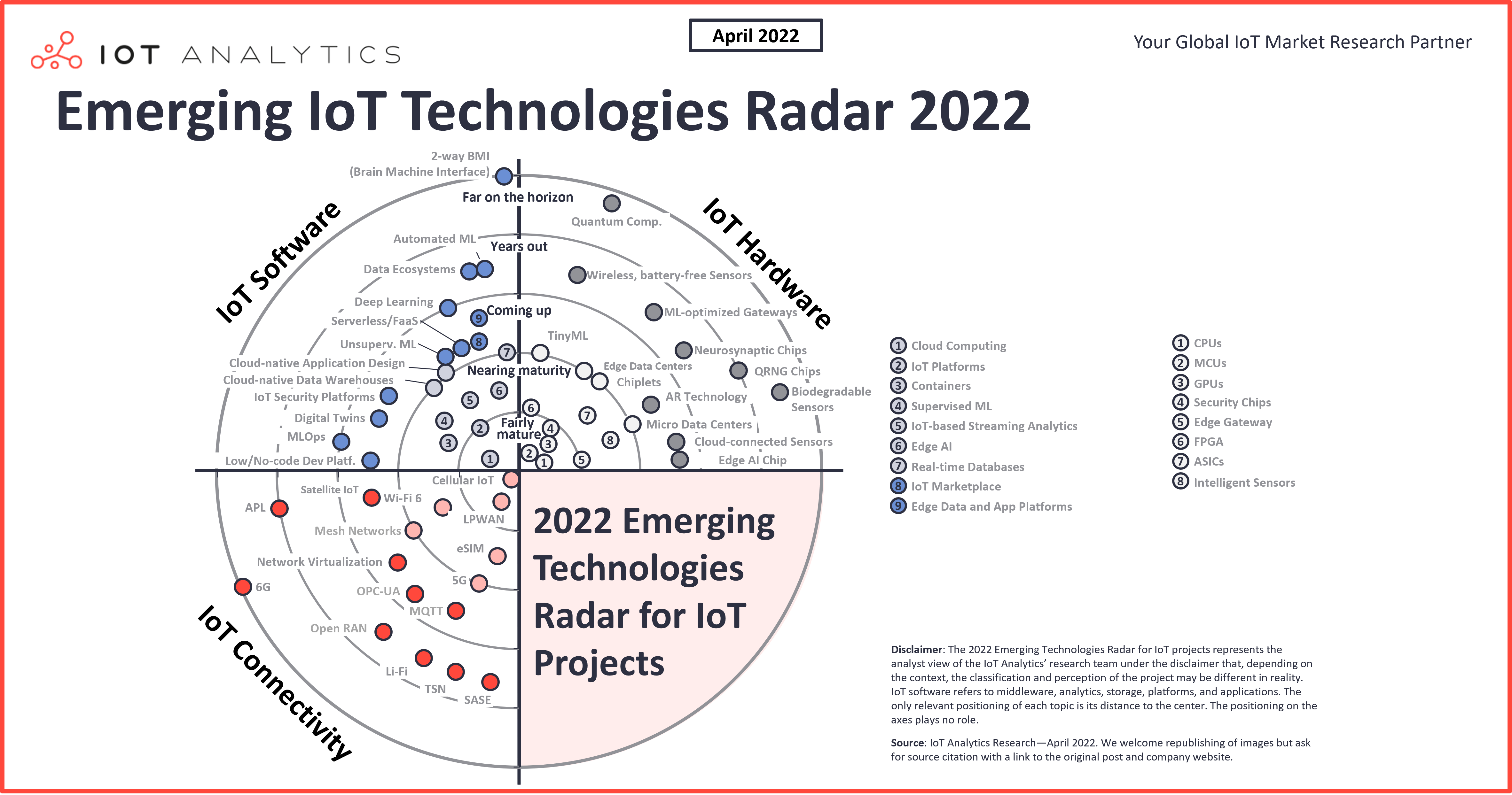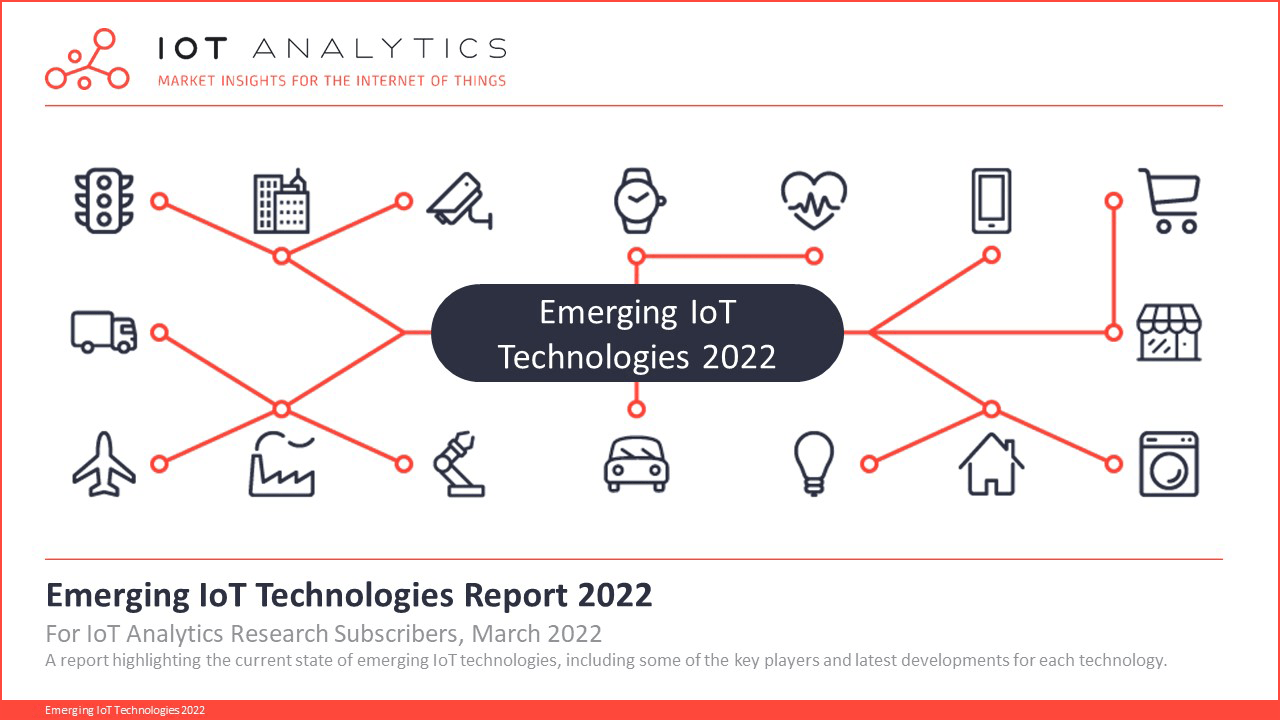
In short
- IoT Analytics identified 58 technologies that people working on IoT projects should have on their radar: 21 in IoT software, 21 in IoT hardware, and 16 in IoT connectivity.
- Of the 58 technologies on the radar, only a few are classified as nearing maturity, fairly mature, or mainstream—many of them are still further out and will need time to reach mass market maturity.
Why it matters
- The radar helps anyone working in IoT environments and projects understand which technologies they should be watching, evaluating, and perhaps deploying.
Selected highlights
The analyst team at IoT Analytics handpicked 58 of the most promising technologies relevant to IoT projects globally and ranked them according to their perceived maturity. The resulting Emerging IoT Technologies Radar will help anyone working in IoT-type environments and projects understand which technologies they should be watching, evaluating, and perhaps deploying.
The full report is available to IoT Analytics corporate subscription clients here: Emerging IoT Technologies Report 2022. The report contains additional details, such as market statistics, major vendors, and recent trends, for each of the highlighted IoT technologies, which are anywhere between “coming up” and “mainstream.” The report is an update to the 2019 analysis on emerging IoT technologies.
IoT Software. Eight IoT technologies are nearing maturity, including edge AI, IoT-based streaming analytics, and supervised and unsupervised machine learning.
IoT Hardware. Six IoT technologies are now classified as fairly mature or mainstream: CPUs, MCUs, GPUs, security chips, FPGA, and edge gateways.
IoT Connectivity. Four IoT technologies are close to maturity: eSIM, mesh networks, 5G, and Wi-Fi 6.
The IoT technologies maturing the fastest
Of the 40 technologies that were highlighted in the 2019 radar, three technologies stand out as the fastest movers that advanced the most in three years: Wi-Fi 6, GPUs, and intelligent sensors.
- Wi-Fi 6. The deployment of Wi-Fi 6 chipsets at an early stage and the significant specification upgrade from earlier Wi-Fi versions led to a fast adoption by device players, especially in devices such as routers. Thanks to this adoption, Wi-Fi 6 has been extremely quick to move from “coming up” to “fairly mature.” Wi-Fi 6 significantly increases the speed and the network’s capacity to provide optimal throughput to access points. The upgrade from older Wi-Fi versions to Wi-Fi 6 opens the door for new applications, with almost four times higher throughput capacity than Wi-Fi 5. Routers, gateways, and customer-premises equipment (CPEs) were key devices for the quick adoption of Wi-Fi 6 in the last three years.
- GPUs. The optimization of GPUs to train AI deep learning models to process multiple computations simultaneously for IoT applications and the adoption of GPUs into data centers due to their parallel processing capabilities have led to faster maturity.
- Intelligent sensors. The last three years have seen an upsurge in technology developments around sensors that aim to solve problems related to latency, data throughput, and security for various edge applications. In contrast to older generation sensors, these new sensors are embedded with data processing capabilities that enable data to be processed closer to the sensor and respond to the user interface or actuators. Some of the applications driving the adoption of intelligent sensors were wearable medical devices, such as blood glucose monitors, and AI-based quality control in manufacturing.
Here is a complete list of all software, hardware, and IoT connectivity technologies (ranked by maturity):

A. IoT Software Technologies
| Technology | Description | Classification | Adoption Rate |
|---|---|---|---|
| Cloud Computing | Cloud computing is the delivery of different services through the internet. These resources include tools and applications related to data storage, servers, databases, networking, and software. | Mainstream |  |
| IoT Platforms | IoT platforms are software tools for building and managing IoT solutions. They also simplify coding and deploying applications for IoT solutions and enable efficient edge-to-cloud communications. | Fairly mature |  |
| Edge AI/Analytics | Edge AI is a combination of edge computing and AI. AI algorithms are processed locally, either directly on the device or on a server near the device. | Nearing maturity |  |
| Containers | A container is a standard unit of software that packages up code and all its dependencies, so the application runs quickly and reliably from one computing environment to another. | Nearing maturity |  |
| IoT-based Streaming Analytics | Streaming analytics is the processing and analysis of fast-moving live data from various sources, including IoT devices, to raise automated, real-time actions or alerts. | Nearing maturity |  |
| Supervised ML | Supervised ML is a subcategory of ML and AI. It is defined by its use of labeled datasets to train algorithms to classify data or predict outcomes accurately. | Nearing maturity |  |
| Cloud-native Application Design | A cloud-native application is a program designed for a cloud computing architecture. These applications are run and hosted in the cloud. | Nearing Maturity |  |
| Cloud-native Data Warehouses | A cloud-native data warehouse is a database delivered in a public cloud as a managed service that is optimized for analytics, scale, and ease of use. | Nearing Maturity |  |
| Real-time Database | A real-time database is a database system that uses real-time processing to handle workloads whose state is constantly changing. | Nearing Maturity |  |
| Low-code/No-code Development Platforms | A low-code/no-code development platform provides a development environment to create application software through a graphical user interface. | Nearing Maturity |  |
| Unsupervised ML | Unsupervised ML is a type of ML in which the algorithm is not provided with any pre-assigned labels or scores for the training data. | Coming up |  |
| Serverless/FaaS | Function-as-a-Service, or FaaS, is a cloud computing service that allows developers to build, run, and manage application packages as functions without having to maintain their infrastructure. | Coming up |  |
| Deep Learning | Deep learning is part of a broader family of ML methods based on data representations, as opposed to task-specific algorithms. | Coming up |  |
| IoT Marketplaces | An IoT marketplace is a type of application marketplace where customers can go to an online storefront to find, purchase, and manage applications for their IoT devices. | Coming up |  |
| Digital Twins | A digital twin is a digital representation of a physical object, process, or service. | Coming up |  |
| IoT Security Platforms | An IoT security platform includes software security solutions for many layers of the IoT tech stack. | Coming up |  |
| IoT Edge Data & Application Platforms | Edge application platforms enable analytics application management at the edge. Edge data platforms are software tools to manage applications running on multiple edge compute resources. | Coming up |  |
| ML Ops | ML Ops (also called DevOps for ML) is an engineering discipline that aims to combine ML systems development and deployment. | Coming up |  |
| Automated ML | Automated machine learning is the process of automating the tasks of applying machine learning to real-world problems. | Years out |  |
| Data ecosystems | A data ecosystem is the secure connection between different stakeholders of a process (e.g., vendors, suppliers, etc.) that share data in a way that has clearly defined rules for data access and privacy for everyone involved. | Years out |  |
| 2-way BMI (Brain Machine Interface) | Bidirectional brain-machine interfaces (BMIs) establish a two-way direct communication link between the brain and the external world | Far on the horizon | New entry |
B. IoT Hardware Technologies
| Technology | Description | Classification | Adoption Rate |
|---|---|---|---|
| CPU | CPUs are electronic circuitry that execute instructions that make up a computer program. | Mainstream |  |
| MCU | Microcontrollers are integrated circuits that contain a processor, memory, and other peripherals. | Mainstream |  |
| GPUs | Graphic processing unit | Mainstream |  |
| Security Chips | Security-enhancing, low-powered modules, include various security-sensitive functions | Fairly mature |  |
| Edge Gateways | Physical devices that serve as the connection point between the cloud and controllers, sensors, and intelligent devices. | Fairly mature |  |
| FPGA | Field programmable gate array | Fairly mature |  |
| Intelligent Sensors | Sensors that take some predefined action when they sense the appropriate input. | Nearing maturity |  |
| ASIC | Application-specific integrated circuit | Nearing maturity |  |
| Chiplets | Chiplets are a new design philosophy that allows multiple chips with different process node sizes to be used in a single package or on a single substrate. | Nearing maturity |  |
| TinyML | TinyML is a field of study in ML and embedded systems that explores models you can run on small, low-powered devices, like microcontrollers. | Nearing maturity |  |
| Edge + Micro Data Centers (MDCs) | Edge data centers are located close to the edge of a network (where the network meets the endpoint layer). An MDC is for computer workloads not requiring traditional facilities. | Nearing maturity |  |
| Cloud-connected Sensors | Cloud-connected sensors use physical sensors to accumulate data and transmit them into a cloud computing infrastructure. | Coming up |  |
| AR Technology | AR technology is a technology that combines virtual information with the real world. | Coming up |  |
| Edge AI Chip | Edge AI chipsets refer to computational chipsets focusing on AI workloads that are typically deployed in edge environments. | Coming up |  |
| Neurosynaptic Chips | Brain-inspired computer chip, in which transistors simulate neurons and synapses. | Years out |  |
| QRNG Chips | QRNG refers to quantum driven secure chip design which can be integrated into current silicon design and manufacturing processes. | Years out |  |
| Wireless, Battery-free Sensors | Sensors that can generate the energy that they need to function by themselves, i.e., they do not need to be powered by an external source. | Years out |  |
| ML-optimized Gateways | Controllers that are optimized for ML algorithms. | Years out |  |
| Quantum Computing | Computation using quantum-mechanical phenomena, for example superposition entanglement. | Far on the horizon |  |
| Biodegradable Sensors | Biodegradable sensors are designed and developed to detect various body signals, which can help track post-treatment prognosis. | Far on the horizon | New entry |
C. IoT Connectivity Technologies
| Technology | Description | Classification | Adoption Rate |
|---|---|---|---|
| Cellular IoT (2G/3G/4G) | Provides connectivity to IoT applications via traditional cellular networks | Mainstream |  |
| LPWAN | Low-power, wide-area connectivity for IoT applications (e.g., Sigfox, LoRa, NB-IoT, and LTE-M) | Mainstream |  |
| eSIM | A SIM-card embedded into mobile devices enables remote SIM provisioning, which allows storing multiple operator profiles simultaneously and switching between them remotely. | Nearing maturity |  |
| Mesh Networks | A mesh network is a group of devices that act as a single Wi-Fi network, so there are multiple sources of Wi-Fi around your house instead of just a single router. | Nearing maturity |  |
| 5G | The fifth generation of cellular networks, commercially launched in 2019 | Nearing maturity |  |
| Wi-Fi 6 | The newest version of the Wi-Fi protocol, also known as IEE 802.11ax | Nearing maturity |  |
| Network Virtualization | Abstracts network elements and resources into a logical virtual network that runs independently on top of a physical network | Coming up |  |
| MQTT | MQTT is a lightweight, publish-subscribe network protocol that transports messages between devices. | Coming up |  |
| OPC Unified Architecture (UA) | OPC UA is a machine-to-machine communication protocol for industrial automation from the OPC Foundation. | Coming up |  |
| Satellite IoT | Provides connectivity to IoT applications via satellite networks | Coming up |  |
| TSN | Time-Sensitive Networking is a set of standards defined by the IEEE for the time-sensitive transmission of data over deterministic Ethernet networks. | Years out |  |
| Li-Fi | Wireless communication technology that uses light to transmit data | Years out |  |
| Open RAN | Open RAN (Open Radio Access Networks or O-RAN) is the disaggregation of RAN functionalities through network virtualization and software-defined network technologies. | Years out |  |
| Advanced Physical Layer (APL) | Developing industrial Ethernet standard that seeks to leverage the work of the IEEE 802.3cg (10BASE-T1L) task force to achieve a single twisted-pair industrial Ethernet standard for hazardous areas | Years out |  |
| Secure Access Service Edge (SASE) | SASE is a new security model specifically to address the security challenges of the new reality organizations are facing. | Years out |  |
| 6G | The sixth generation of cellular networks | Far on the horizon |  |
= Very fast movers
= Fast movers
= Slow movers
What the radar does and does not measure
Technology maturity. The radar shows a subjective measure of maturity as put together by the analyst team at IoT Analytics. The maturity scores are developed based on expert interviews, vendor briefings, secondary research, and conference attendances. The radar targets IoT practitioners that deploy IoT.
The IoT. IoT Analytics defines the IoT as a network of internet-enabled physical objects. Objects that become internet-enabled (IoT devices) typically interact via embedded systems, some form of network communications, and a combination of edge and cloud computing. The data from IoT-connected devices is often (but not exclusively) used to create novel end-user applications. Connected personal computers, tablets, and smartphones are not considered IoT, although these may be part of the solution setup. Devices connected via simple connectivity methods, such as RFID or QR codes, are not considered IoT devices.
Relevance of individual technologies. Not every technology is relevant for a given IoT context. Some technologies may only be used in specific IoT settings (e.g., low-power WAN [LPWAN] for remote, low-power applications), while others are used in settings where IoT only plays a minor role (e.g., cloud computing, which is also used in many non-IoT scenarios). IoT Analytics is aware that many other technologies exist that could be highlighted on such a radar.
More Information and further reading
Are you interested in learning more about IoT technologies?
The Emerging Technologies Report 2022 is a 76-page report highlighting the current state of emerging IoT technologies, including some of the key players and the latest developments for each technology.

The report consists of four parts:
- Emerging Technologies Radar (Framework and criteria to classify selected technologies and overall view on classifications—6 pages)
- Software Technologies (Deep dive into selected software technologies and one-pagers on the most interesting technologies—21 pages)
- Hardware Technologies (Deep dive into selected hardware technologies and one-pagers on the most interesting technologies—29 pages)
- Connectivity Technologies (Deep dive into selected connectivity technologies and one-pagers on the most interesting technologies—15 pages)
Sample
The sample of the report gives you a holistic overview of the available analysis (outline, key slides). The sample also provides additional context on the topic and describes the methodology of the analysis. You can download the sample here:
Related articles
You may be interested in the following articles:
- 40+ Emerging IoT Technologies you should have on your radar
- Global IoT market size grew 22% in 2021 — these 16 factors affect the growth trajectory to 2027
- 10 IoT technology trends to watch In 2022
IoT Analytics Corporate Research Subscription
For complete enterprise IoT coverage with access to all IoT Analytics’ paid content & reports including dedicated analyst time check out Enterprise subscription.
Staying up to date on our research
Subscribe to our newsletter and follow us on LinkedIn and Twitter to stay up to date on the latest trends shaping the IoT markets.

